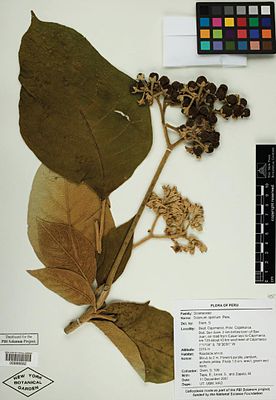Solanum dillonii
| Solanum dillonii | ||||||||||||
|---|---|---|---|---|---|---|---|---|---|---|---|---|

Isotype of Solanum dillonii |
||||||||||||
| Systematics | ||||||||||||
|
||||||||||||
| Scientific name | ||||||||||||
| Solanum dillonii | ||||||||||||
| S.Knapp |
Solanum dillonii is a species ofthe nightshade family (Solanaceae). It was first described in 2010 and isnative tosouthern Ecuador and northern Peru .
description
Solanum dillonii grows as a shrub or small tree that can reach heights of 4 to 8 meters. The trunk only branches in the upper part and is densely covered with trichomes , which fall off with increasing age. The trichomes are 0.5 to 1 millimeter long, are multi-row and branch out. The young shoots are covered with branching, multi-row trichomes, which are between 0.5 and 1 millimeter long and are grayish white in color. The bark of older trunks is reddish brown in color.
The sympodial units include some leaves . The simple leaves are between 12 and 30 inches long and between 4.5 and 16 inches wide. The leaf blade is elliptical to broadly elliptical in shape, with entire margins, tip and base are pointed. The upper side of the leaf is evenly covered with star-shaped branching, one- to three-row trichomes. The underside of the leaf is covered with branching, multi-row trichomes, whereby the rows can be 10 to 16 up to 1 millimeter long. Nine to eleven pairs of primary leaf veins extend from the leaf axis and turn yellowish green when they dry out. The 1.5 to 3 centimeter long petiole is densely covered with branched trichomes.
The inflorescences are terminal on the stems. They are 15 to 20 centimeters long and have multiple branches. Each of the inflorescences consists of 100 or more flowers. The inflorescence is densely hairy with branched trichomes, which are between 0.18 and 1.5 millimeters long. The flower stalk , nodding during flowering , is 7 to 10 centimeters long and about 2 millimeters thick at the base and between 2.5 and 3 millimeters thick at the tip. It is densely covered with trichomes and bent like a joint at the base. The flower stalks are 7 to 9 millimeters long and about 1 millimeter apart.
The five-fold flowers are always fully developed. The cup-shaped calyx tube is between 3 and 3.5 millimeters long and covered with 2.5 to 3 millimeters long, triangular lobes. The dense hair on the underside of the calyx resembles that of the rest of the inflorescence. The purple crown measures 1.3 to 1.5 centimeters in diameter, lobes in a star shape up to three quarters of the way to the base. The corolla lobes are 6 to 7 millimeters long and 3.5 to 4.5 millimeters wide, and their edges and tips are densely hairy. The hairless stamens have grown together to form a tube, and the free-standing part is between 2.5 and 3 millimeters long. The yellow anthers are elliptical in shape with a length of 3 to 3.5 millimeters and a width of about 1 millimeter. They open through pores at the tips, which enlarge into slits with age. The ovary is densely hairy with branching trichomes. The stylus is 9 to 9.5 millimeters long and sparsely covered with branching, four- to eight-row trichomes. The club-shaped scar is finely papillary.
As fruits are ripe, dark green colored berries are formed, which are spherical with a diameter of 1 to 1.5 centimeters. The pericarp, which is unevenly covered with branching trichomes, is thin and not shiny. The berries are on a woody, more or less upright stem that is 1.2 to 1.5 centimeters long and about 3 millimeters thick at the base. Each of the berries bears more than 200 reddish to golden brown seeds. With a length of 1.5 to 2 millimeters and a width of 1 to 1.5 millimeters, these are flat-kidney-shaped and have a finely grained surface.
distribution and habitat
Solanum Dillonii comes in in southern Ecuador situated Loja province and in the northern Peru region located Cajamarca before. The species thrives at altitudes of 1500 to 2200 meters, where it grows in tropical wet forests on the western slopes of the Andes and in the valley of the Río Marañón . You can find them there mainly along paths and small watercourses.
Systematics
It was first described as Solanum dillonii in 2010 by Sandra Knapp in PhytoKeys number 1, page 39. The specific epithet dillonii honors the American botanist Michael Dillon , who has made a name for himself in researching the flora of northern Peru.
swell
- Sandra Knapp: New species of Solanum (Solanaceae) from Peru and Ecuador . In: PhytoKeys . No. 1 , 2010, ISSN 1314-2003 , p. 39-42 , doi : 10.3897 / phytokeys.1.659 .
Individual evidence
- ↑ a b c d e f g Sandra Knapp: New species of Solanum (Solanaceae) from Peru and Ecuador . In: PhytoKeys . No. 1 , 2010, ISSN 1314-2003 , p. 39-42 , doi : 10.3897 / phytokeys.1.659 .
- ↑ Solanum dillonii. In: The International Plant Names Index. www.ipni.org, accessed February 9, 2013 .